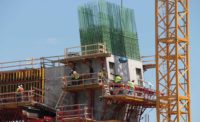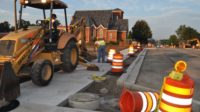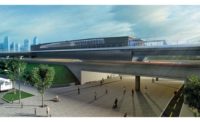A group of former state transportation department leaders say the main piece missing from the $1.3 trillion infrastructure bill is money.
They’re not alone in that assessment, which they shared during a panel discussion webinar on Sept. 23. The latest ASCE report card for America’s infrastructure estimates a $2.6 trillion gap between what’s needed to maintain U.S. infrastructure through 2029 and the investment that has actually been made. But there are potential new sources of revenue the experts said could provide more money for U.S. infrastructure.
As passed by the Senate in August, the bipartisan bill includes $110 billion for roads and bridges, $66 billion for rail, $39 billion for public transit repair, $25 billion for airports, $17 billion for ports, $7.5 billion for low-carbon public transit and $7.5 billion for electric vehicle charging stations, among other funding.
But that funding isn't enough, panelists said. More money is needed for maintenance, state and federal gas taxes aren't keeping up with need, and the federal gas tax hasn't increased since 1993, said Paul Mattox, former secretary of the West Virginia Department of Transportation. Outside of patches and repairs, he added that roads and bridges have been largely neglected for decades, leaving a lot of work that needs to be done but hasn’t been funded.
“We’re basically managing the decline of the existing system,” Mattox said.
Mattox pointed to the idea of creating a federal infrastructure bank as one funding option. An infrastructure bank would allow private investment to fund roads, bridges and other infrastructure. Some lawmakers have supported the idea and a bipartisan bill introduced earlier this year would create an Infrastructure Financing Authority, though the legislation hasn’t advanced past being introduced in the House or the Senate.
Former Ohio Department of Transportation Assistant Director Jim Barna said other forms of private investment can also give large projects a boost. As ENR previously reported, Ohio completed its first-ever P3 project in 2019, the $645 million design-build-finance-operate-maintain Portsmouth Bypass. Pointing to the Brent Spence Bridge, which carries I-71 and I-75 across the Ohio River between Cincinnati and Northern Kentucky and needs to be replaced, Barna said incentives like an added toll could help draw private investment to pay for a new bridge.
“There’s a lot of private sector monies out there that want to get into infrastructure,” he said. “We need to look at ways to make that easier, and make it more palatable to the public.”
Some of the former DOT officials also spoke about potential new forms of user funding to pay for roads. In North Carolina, former NCDOT Secretary Nick Tennyson said one proposal in the state calls for incremental fees for all package delivery services, which cause a lot of wear and tear on roads. That would also be a way of helping get people who live in urban areas and don’t own cars to help pay for roads, since they take advantage of those roads by getting deliveries but don’t pay any gas tax or tolls themselves.
The experts said tolls can help, but they also have limits to their usefulness. Mattox said that in rural areas of West Virginia where the hilly terrain increases the per-mile cost of building roads, a toll would not recoup enough money.
Tennyson lamented that North Carolina can’t target out-of-state drivers with higher tolls, as the federal government has strict rules on interstate highway tolls. Additionally, he said many drivers avoid the state’s gas tax when passing through on I-95 by filling up their tanks in Virginia and then again after reaching South Carolina.
“We just maintain their pathway to Disney World, I guess,” Tennyson said.
There’s always the option of trying to raise taxes. Mattox said a 1% federal sales tax dedicated to transportation should be discussed and vetted, though he acknowledged the political difficulties of making that happen.
“I know everybody is anti-tax and we can’t even get folks in support of raising the fuel tax … but there definitely has to be some new form of revenue to address the shortfall in terms of maintaining our infrastructure and getting it to a state of good working order,” he said.
Wherever additional funding comes from, the former DOT leaders agreed the bill passed by the Senate would be a start.
“I tell folks this makes a good down payment on what is actually needed for infrastructure in this country,” Mattox said.






